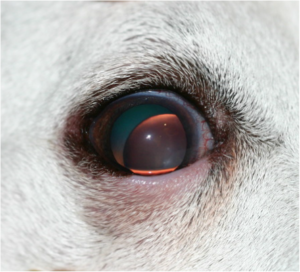How to Treat Lens Luxation in Dogs and Cats
Written by: Laura Switkowski, Licensed Veterinary Technician
What is Lens Luxation?
A lens luxation is a condition in a pet where the lens inside of the eye is dislocated from the normal position it should be in. How does this happen? The lens is held in place by special ligaments called zonules. For some reason these zonules that hold the lens in place can rupture. This leads the lens to break free. The lens can float to the front of the eye in front of the iris (the colored portion of the eye), or behind the iris in the posterior or back of the eye. When the lens is forward in front of the iris it is called an anterior luxated lens. When the lens falls into the back of the eye it is called a posterior luxated lens.
This condition can be primary, meaning it happened on its own, or it can be secondary, meaning that it happened as a result of something else. Certain breeds such as terriers and older cats can have lens luxations happen as a primary cause. Secondary causes can be caused from diseases such as glaucoma, uveitis (inflammation of the uvea), or retinal diseases. This is because inflammation inside of the eye can cause these zonules to break down.
How Are Luxations Treated?
Treatment depends on the placement of the lens. If the lens is posterior or in the back of the eye, medications can be used to keep the pets pupil small. By keeping the pupil small, the lens is not able to fit through the pupil to come forward. A common medication that is used for this is called Latanoprost. This is also a glaucoma medication, so it may cause the eye pressure to lower. If the lens is anterior it can be a bit more complicated.
When the lens is anterior, in front of the iris, the lens can block the drainage angle of the eye. This blocks fluid from exiting the eye, which leads to excess pressure in the eye called glaucoma. Treatment for the anterior lens luxation is different than the posterior luxation. If Latanoprost was used to make the pupil smaller if the lens was forward, it would trap the lens forward and close off the draining angle creating more pressure in the eye.
Surgery Options
Treatment for an anterior luxated lens would be either a surgery called a lensectomy, or a procedure called couching. For the lensectomy, the surgeon will go into the eye and take the lens completely out. This can have complications. It is possible that during surgery the retina can detach, which would lead to blindness.
Couching is a procedure where a pet is typically sedated, the eye is dilated in hopes that the lens will fall back into the posterior section of the eye to avoid glaucoma. Sometimes, the doctor will place pressure on the cornea to force the lens to fall back. This is not always successful, and surgery may be recommended if the lens will not fall back. Ultimately if the lens is forward with glaucoma and the eye is blind, enucleation will be recommended in order to keep the pet pain free.

A picture my staff and I took from Veterinary Vision of Rochester showing a posterior luxated lens.
Interested in becoming a Veterinary Assistant?
Blackstone Career Institute’s accredited online veterinary assistant courses offer a quality education covering the behavior, care, and treatment of animals. A veterinary assistant works on the animal care team under the supervision of a veterinary technician and a veterinarian.
Gain a working knowledge of the veterinary assistant field, including veterinary assistant salary information, veterinary anatomy, medical terminology, veterinary office administrative office skills, animal care and handling, office technology, time and stress management, critical thinking skills, and working effectively on a team.
Fast virtual degrees offer an amazing opportunity to learn and improve your skill sets. Prepare for your veterinary assistant career with online veterinary assistant training from Blackstone Career Institute and discover the rewards of working in this exciting animal care field.













